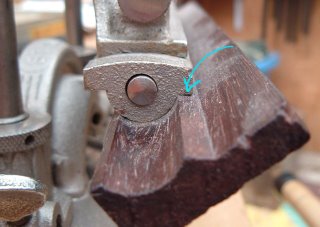Yes, been back to the #55 to renew the battle and, well, that's it. I ain't doing it any more. I'll write about the #405. I'll wax lyrical about the #043. The #50, #044 and #46 hold no fears. But that darn #55 I ain't wasting a second longer on. It's the total pits. The straw that broke this camel's back? That ruddy fence.
Following my vow to go by the manual and do what it showed next, I started to set it up for chamfering. The rosewood faces on the #55's fence have a profile on the backside that should make setting the fences up at 45° a snap. See? Where the blue arrow's pointing.

Well the smaller, less fancy fence was spot on. The other one though, it didn't look good, so I offered up a square to see how far off it was.

I believe my annotation expresses my feelings fairly adequately...
Now I daresay I could scrape the profile, or maybe it's the casting that needs - guess what - a file, but frankly this has got ridiculous. How on earth can I give a balanced view on the #55 and how well it works when I'm basing it on this stinker of an example? Well I can't, can I?
'Course it's gonna take delicacy to express this to the would-be article requester, but as I say, anything you like on the 043, 044, 50, 405, 46, Lewin...

How disappointing, Alf. It would have been nice to read one of your delightfully amusing and informative reviews on the #55. There are undoubtedly good #55s about (such as the one MikeW had), it's just a pity they didn't have CNC machines in those days, so getting a good example of a tool of the complexity of the #55 is always going to be a bit hit and miss.
ReplyDeletePaul Chapman
A lot of people have difficulty with the #55, including Patrick Leach. I'm beginning to think the combination planes are a distraction -- there's so many pieces to hunt after, and they do tend to be fiddly.
ReplyDeleteLike this excerpt from the #55 page:
"The right fence also has a rosewood face that can be titled up to 45 degrees, but it uses conventional wood screws to do that. It doesn't have the fine adjustment that the left fence does. Instead, this fence has a flat outside (the side opposite the rosewood face), which makes it possible to flip the fence around and use this face as a fence. Since the fence is supported by curved arms, this feature allows the plane to be worked farther from the edge than it normally would be.
It's very important to position the left and right fences properly in order for the plane to work. Since the rosewood face can pivot, catastrophic (in the planing sense) results can occur if particular attention is not paid during set-up. The rosewood face must be perfectly parallel to the side of the cutter. If it isn't, the plane will bind - the cutter will tend to draw the fence tighter and tighter to the edge, the deeper it cuts - or the plane will ride off the board - the cutter pushes the fence away from the board's edge, the deeper it cuts."
Sounds way too fiddly for my taste. I have a #45 and a #46 (as well as an 043), but I don't think I'd enjoy a #55.
But Patrick Leach hated the #45 as well, so what does he know!!!
ReplyDeletePaul Chapman
Designed finickiness I was prepared for - it's the manufactured finickiness on this particular example that's more than mortal galoot can bear. And I think it's always as well to remember Mr Leach doesn't necessarily let a balanced view get in the way of comic effect... ;~)
ReplyDeletePaul, maybe I'll have to do something comic on what can go wrong with a #55 instead? :~)
Why not, Alf? They say that laughter is the best medicine and you probably need some after the torture that particular #55 has caused you.
ReplyDeletePaul